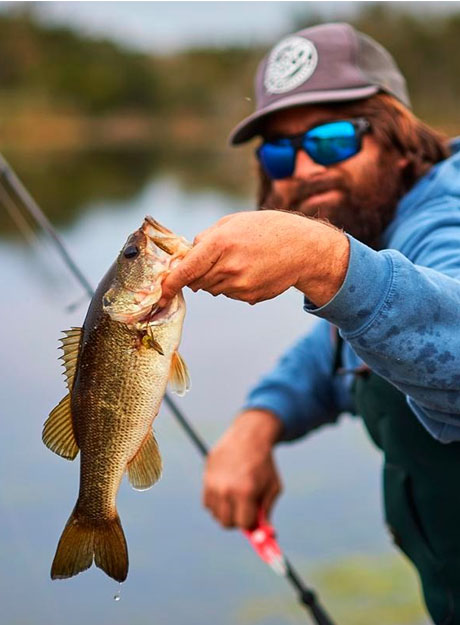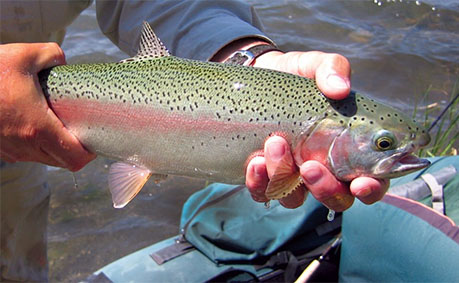The tarpon is a fun, acrobatic fish to catch. They are found in the Atlantic ocean, both inshore and offshore. When targeting these fish, anglers should try bait casting, drift fishing, fly fishing, jigging, night fishing, spin casting, still fishing, surf casting, and top water fishing.
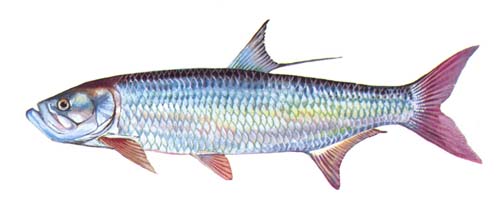
Habitat: Bay, Ocean, Coastal Waters
Tarpon are migratory fish. During their lifetime—of up to 50 years—tarpon will travel thousands of miles throughout their range which extends from the southern Atlantic coast of North America to central Brazil. The largest concentrations of Tarpon are found west of the Florida peninsula in the Gulf of Mexico between April and July.
Each year in early spring tarpon begin migrating from their winter home near Central America and migrate north into the Gulf to feed and spawn. Along their journey they can be found in the bays, passes and canals extending from the coast of Texas to the Florida Keys. The key to catching tarpon is being in the right place, at the right time, with the right bait.
- How to identify Tarpon
- Where to catch Tarpon
- Top Tarpon Fishing Spots
- How to Catch Tarpon: Fishing Techniques
- Best Tarpon Lures, Bait & Tackle
How to identify Tarpon
Tarpon have flat bodies that are covered with large scales. Their mouths are filled with small, sharp teeth, and their jutting lower jaws give them a bulldog-like appearance. Their dorsal fin doesn’t have any spines and instead consists of 12-16 soft rays and a long, detached posterior tip.
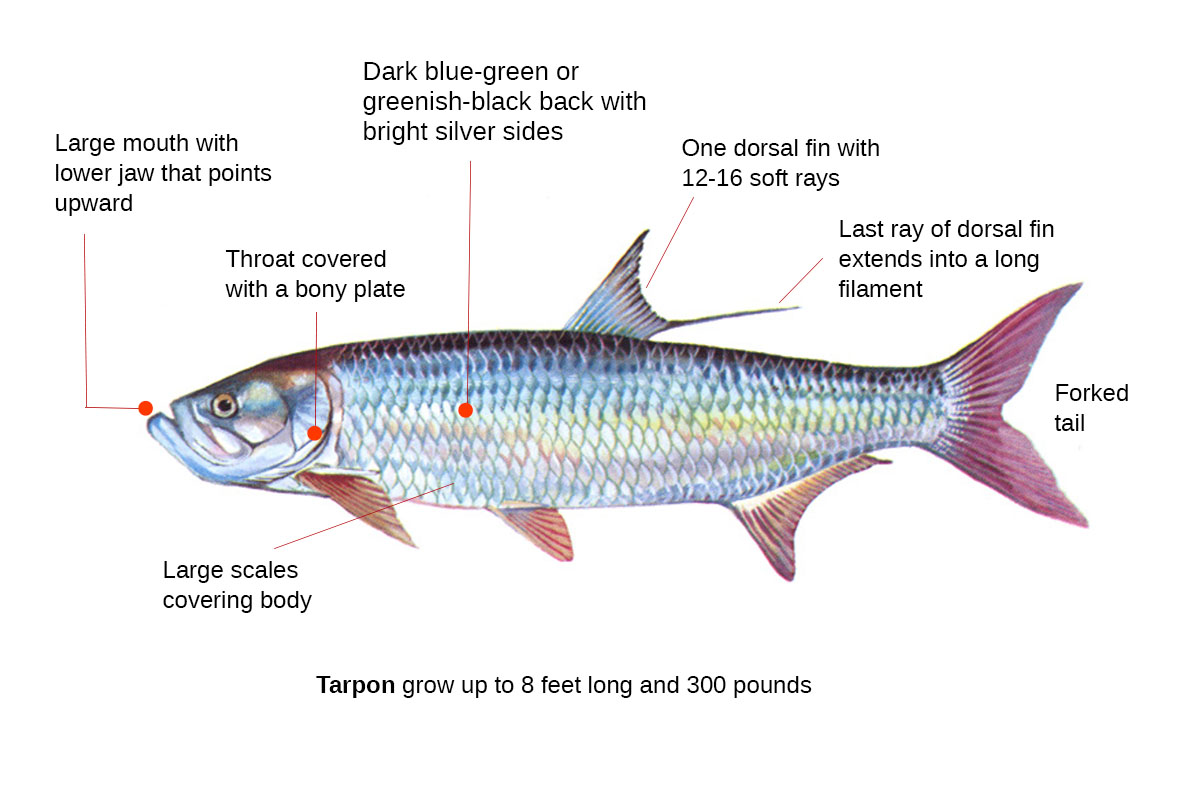
The coloring on their backs varies depending on the time of day. They appear turquoise during the day and silverish black at night. Their sides and abdomen are a vibrant silver color. When these fish venture inland into brackish water, they change to a golden brown color due to the tannins in the water.
Adult tarpon can reach up to 8 feet in length and weigh 300 pounds.
Where to catch Tarpon
Tarpon are found primarily in the shallow coastal waters of the Atlantic Ocean near the shore and in estuaries. There typical habitat is usually warm, shallow, waters with sandy mud bottoms. They may also be found in open waters, around reefs, and occasionally in freshwater lakes and river inlets to the ocean. Their range extends up the Atlantic coast past Virginia, throughout the Gulf of Mexico and Caribbean Sea, and as far south as central Brazil.
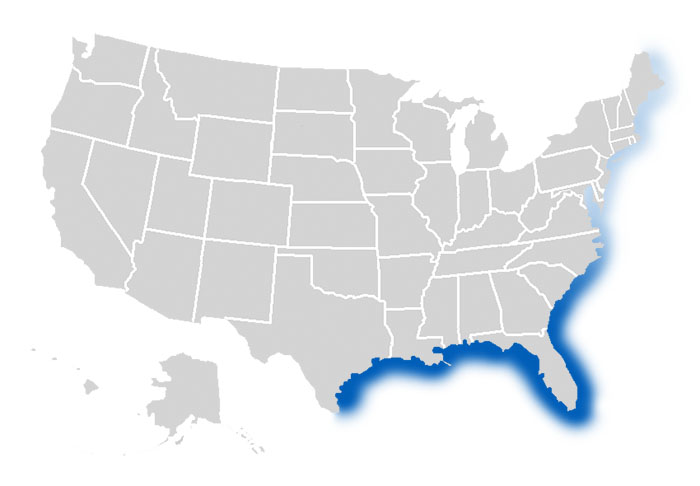
Tarpon often rise to the surface to gulp air and fill their swim bladder that acts as a quasi lung. Due to a well-developed swim bladder, the tarpon is able to survive in brackish water with varying pH and low oxygen levels often uninhabitable by other fish.
Their swim bladder also acts as a floatation device. They’ll occasionally use their air bladder to roll along the surface and maneuver their way into inland waters not accessible by other fish. It’s here that they’ll often choose to rear their young to avoid the threat of predators.
As adolescents tarpon are found in clear waters close to the surface. During this stage they may also enter freshwater rivers. Some will remain in freshwater habits but the majority will move back into oceanic waters as they reach adulthood.
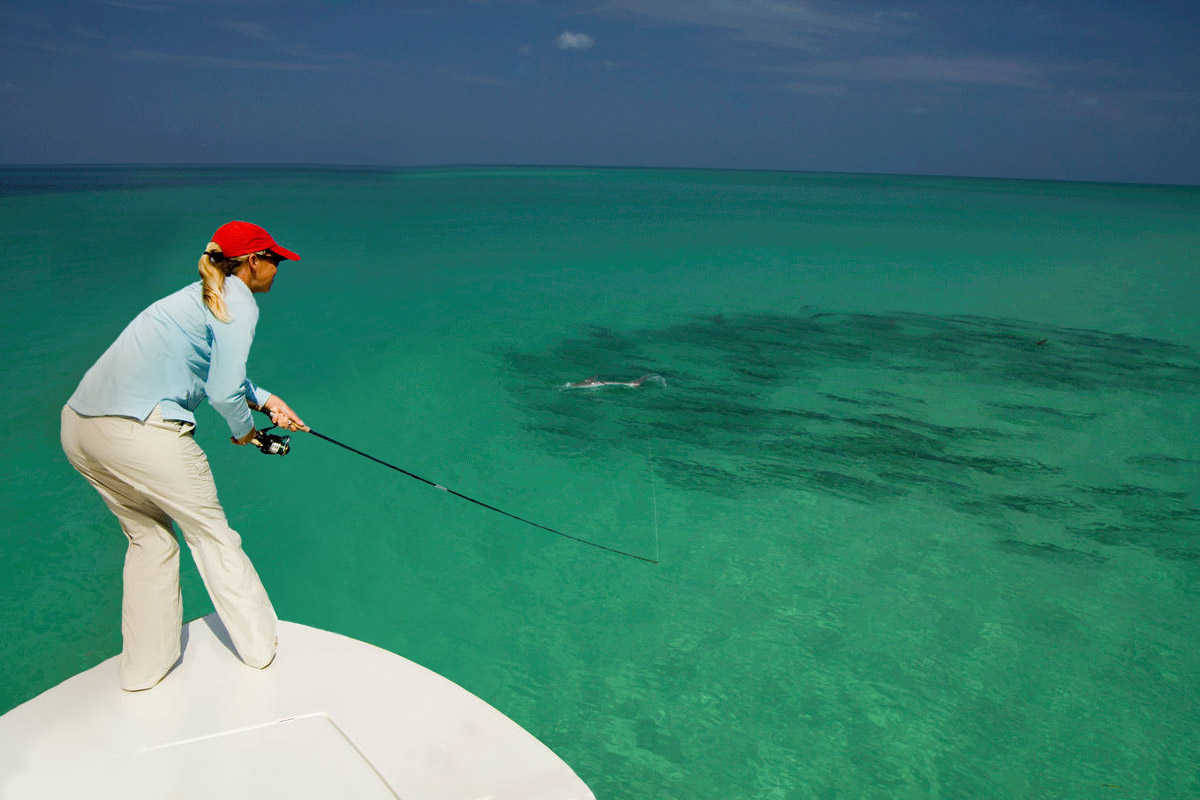
The following are habitats where you can catch Tarpon:
- Backwater Fishing
- Baitfish Schools
- Bays
- Estuaries
- Breakers
- Channel Entrances
- Jetties and Breakers
- Man-made Structures
- Mangroves
- Piers, Docks and Pilings
- Saltwater Tides
- Surf and Shore
- Tidal Flats
Top Tarpon Fishing Spots
While tarpon can be found along much of the Atlantic coast, they prefer the warmer in-shore oceanic waters around the Florida peninsula. In fact, the Florida Keys is an epicenter of tarpon activity and one of the top tarpon-fishing destination in the world. The flats, shallow “lakes”, mangroves, waterways and channels throughout the Keys provide anglers an unparalleled opportunity to catch this giant fish fly fishing, sight-fishing, or bait casting.

| Homosassa Flats (Florida) | Top destination for fishing giant tarpon in excess of 200 pounds. Peak fishing season for tarpon is April through July. Coordinates: 28.7852723, -82.636132 View map |
| Crystal River (Florida) | One of the largest seagrass meadows in the world. Clear clean water with abundant tarpon. Peak fishing season for tarpon is April through July. Coordinates: 28.921465, -82.679580 view map |
| Fort Myers, Florida | Some of the best tarpon fishing is found near Fort Myers inshore bays and beaches, and around Sanibel and Captiva Islands. Tarpon fishing is best after water temperatures rise above 75 degrees Fahrenheit in late spring through late fall. April, May, June and September are the best tarpon fishing months. Coordinates: 26.475237, -82.092796 view map |
| Matlacha and Pine Island, Florida | Miles of shallow flats, backcountry channels and mangrove islands that provide excellent tarpon fishing. Ideal location for tarpon fishing from a kayak or small boat. Coordinates: 26.641761, -82.084221 view map |
| Port St. Joe and Cape San Blas, Florida | Tarpon migration through Cape San Blas, Port St Joe and Saint Joseph Bay waters from late spring through early fall provide excellent fishing for adult migratory tarpon. Fish the beaches off Cape San Blas. Coordinates: 29.768480, -85.351668 view map |
| Panama City Beach, Florida | Fishing is best from late spring through late summer as Tarpon migrate west toward Alabama. Fish along the Saint Andrew Bay and the connecting pass before reaching Destin. Fly or spin tackle is the most common fishing method here. Coordinates: 30.125771, -85.701279 view map |
| Apalachicola, Florida | Offers multiple bays, bridges, passes and river for superb inshore tarpon fishing during the summer months. From April through July Indian Pass is one of the most popular spots to fish for tarpon as they migrate into the area. Coordinates: 29.721981, -84.979476 view map |
| Boca Grande, Florida | Considered a tarpon mecca. Fish the pass with live bait. Sight-fish the beaches using flies, lures or bait. Hot spots include Charlotte Harbor (east of the pass) Pine Island Sound, the mouths of Myakka, Caloosahatchee and Peace rivers (150 lbs plus). Coordinates: 26.730675, -82.219068 view map |
| Pine Island Sound | Great location for tarpon fishing May through June. Fish the mangrove creeks and shorelines for juvenile tarpon. Fish deeper waters for adult migratory tarpon. Coordinates: 26.601913, -82.165602 view map |
| Naples/Marcho Island, Florida | This area produces catches of migratory tarpon headed north toward Boca Grande. Peak tarpon fishing occurs late March through early June. Coordinates: 26.001180, -81.765683 view map |
| Islamorada, Florida | Excellent tarpon fishing oceanside and in the backcountry north of Islamorada. Fishing is best April through the beginning of July. Considered an epicenter for tarpon fishing. Coordinates: 24.931120, -80.637207 view map |
| Government Cut (Miami, FL) | A manmade fishing channel between Miami Beach and Fisher Island that provides excellent tarpon fishing. Best tarpon fishing occurs just outside the inlet. Coordinates: 25.757756, -80.126601 view map |
| Biscayne Bay (Miami, FL) | Target adult migratory tarpon as they head south toward the Florida Keys in the spring. Target bridges, flats, channels, tidal creeks and covers. Hot spots include Biscayne National Park. Coordinates: 25.527920, -80.222217 view map |
| Stuart, Florida | Tarpon are available year-round in the St. Lucie rivers year-round. Peak fishing is during late spring and summer where the St. Lucie Rivers converge with the Indian River Lagoon. Coordinates: 27.170811, -80.178448 view map |
| Key West, Florida | Key West offers excellent tarpon fishing year-round. Peak tarpon fishing season is April through June. Fishing remains strong March through August. Fly fishing in the flats is most popular. Coordinates: 24.605161, -81.754877 Directions |
| Everglade National Park, Florida | Tarpon fishing is best in coastal areas of the Everglades March through July. Hot spots include Whitewater Bay, Ponce de Leon Bay, the mouths of Broad, Lostsmans, and Shark rivers. Coordinates: 25.287816, -80.976578 view map |
| Carrabelle, Florida | Excellent sight-fishing for tarpon along the bars and shoals May through the end of July. Hots spots include Saint George Sound and Apalachicola Bay. Coordinates: 29.827898, -84.653602 view map |
| Belize coastline | Offers 200 miles of coastline with mangroves, channels, flats and deep holes flush with tarpon. Fish is best April through September. Coordinates: 17.848106, -88.177669 view map |
| Sibun River, Belize | Provides good tarpon fishing year-round. Tarpon catches in the 80 to 180 pound range are common during peak fishing season from April through August. Coordinates: 17.422930, -88.265047 view map |
| Stann Creek, Belize | The estuaries and mouths of the Stann Creek coastline near Dagriga are full of tarpon. Fishing is good year round. Peak tarpon fishing season is April through August. Coordinates: 16.970184, -88.229547 view map |
| Sittee River, Belize | Sittee River just south of Hopkins provides excellent tarpon fishing. It is one of the few truly unspoiled rivers remaining in Belize. The mouth of the river provides the best tarpon fishing from early spring through August. Coordinates: 16.807610, -88.254750 view map |
| Placencia, Belize | The shallow flats off the Placencia Peninsula stretching north to Dangriga provide some of the best tarpon fishing in the world. Hot spots include Monkey River and neighboring lagoons. Coordinates: 16.552713, -88.355817 view map |
| Turneffe Atoll, Belize | Offers great tarpon fishing year round. 30 miles long by 10 miles wide and 20 miles out to see. Experiences large populations of migratory tarpon from April through September. Coordinates: 17.378211, -87.864375 view map |
| Punta Gorda, Belize | Miles of flats and large lagoons that provide excellent tarpon fishing year round. Hot spots for targeting tarpon include the mouth of the Rio Grande river. Coordinates: 16.142828, -88.750453 view map |
| Ambergris Caye, Belize | Provides an excellent 400 sq mile fishery for both juvenille and adult tarpon. Fish the west side of the Mesoamerican Reef for juveniles. For larger migratory tarpon, fish the deeper waters to the east of the reef. Coordinates: 18.068050, -87.993292 view map |
| Northern Yucatan, Mexico | Fish Campeche to Holbox Island. Target brackish-water lagoons and creek for juvenile tarpon. For large tarpon fish open waters near river mouths during last spring and summer. Coordinates: 21.730854, -89.324457 view map |
| Manzanillo, Costa Rica | Large number of tarpon are locates in the coastal waters along Gandoca-Manzanillo National Wildlife Refuge. Hot spots include Gandoca Lagoon (when water is high) and the mouth of Sixaola River. Coordinates: 9.589874, -82.597331 view map |
| San Juan, Puerto Rico | Best tarpon fishing is March through May, and October through December in the lagoons. Hot spots include San Jose and Torrecilla lagoons near the airport. Drift live bait under a float, or cast plastic swim baits, sinking plugs, or weighted flies. Coordinates: 18.424665, -66.022227 view map |
| Rio Colorado, Costa Rica | Best time to fish tarpon in Rio Colorado and neigboring lagoons along Costa Rica's Caribbean coast is January through May, but action can be found through early August. Coordinates: 10.789048, -83.590561 view map |
| Jardines de la Reina, Cuba | 100 miles of shallow flats, channels and mangrove islands with adundant tarpon. Travel restrictions make accessing this destination challenging. Coordinates: 20.850769, -78.911803 view map |
How to Catch Tarpon: Fishing Techniques
Being in the right place at the right time is key to catching tarpon. But there are also several productive methods and techniques for tarpon fishing that will greatly improve your catch rate and provide for a thrilling fishing experience.
Drifting
Drifting fishing is an effective method for targeting tarpon when they’re feeding below the surface. Drift a live quarter to silver dollar size blue or pass crab just before sunrise or after sunset. If you’re only interested in targeting larger tarpon, use slightly larger crabs that are up to 3″ wide across their carapace.
While live crab is the preferred bait, drifting live mullet, ladyfish or pilchard is also effective. When live bait isn’t available, tarpon will also take chunks of dead mullet, ladyfish and imitation mullet lures, such as a soft plastic paddletail on a jig.
The ideal speed for drifting your bait when targeting tarpon is between 1/2 and 1 1/2 mph. If you’re having a difficult time keeping slowing your bait, use a trolling motor or drift sock to slow your speed. Deploying a drift sock from the bow of your boat will also keep you drifting stern first and make it easier to keep your bait down current from your boat’s aft or transom.
When drifting fishing for tarpon you can fish your bait free-line or suspended under a float. When there’s plenting of current, free-lining is the preferred method. When drift is minimum, try suspending your bait about 2 to 3 feet under a float and letting it go in the water.
When drift fishing using a float, anchoring your boat will allow your bait to drift in the current and maintain some distance from the boat. If you’re going to anchor, using a quick-release clip and buoy is highly recommended so you can free the boat as soon as you feel the hook set of a tarpon.
For free lining, maintain your bait in the current about 50 to 100 feet behind the boat. When drifting your bait under a float, reel it in once it reaches a distance of about 100 yards from the boat, then set it adrift again.
The best time to drift fish for tarpon is just before sunrise and just after sunset.
Trolling
Trolling for tarpon isn’t common outside of the northern Gulf of Mexico, but it can be an effective technique when you need to locate scattered fish in deep water. Trolling allows you to present bait at multiple depths and cover a lot of water relatively quickly.
When trolling for tarpon set two baited lines directly behind your boat. The first line should be fished about 30 feet behind the boat in the current. Fish the second line about 50-60 back in the current. You can also fish a free-floating bait off either side, and allow it to drift back to the boat with the current. This is a spread I’ve used several times when targeting tarpon.
Getting your bait at varying depths is key to trolling. This can be accomplished in couple ways. Typically, the farther back your bait in the current, the deeper it will dive. A bait 30 feet behind your boat in the current will be fished at a depth of 2 to 3 feet. At 60 feet out, your lure will likey be about 6 to 8 feet deep. Deploying a down rigger weight is a common method for controlling bait depth while trolling.
Troll slowly (2-2.5 mph max). You want to be going just fast enough for your lure to produce a consistent action, but no faster. If you troll too fast, it will ruin your spread and presentation.
When you get a bite, allow the fish to set the hook. No need to yank the rod as you would when fishing for freshwater bass or trout. At this point you can clear the other trolling rods to create space for the fight, or leave the other lines out to hopefully hook another tarpon.
Fly Fishing
Fly fishing for tarpon is fun and effective. Unlike many saltwater gamefish species, tarpon will readily take a fly if presented in the right way—sometimes when they’re not even hungry.
When tarpon are hungry they can become opportunistic feeders. During these times these times fly selection becomes less important. The real key to catching tarpon with a fly is locating the tarpon and getting your fly in front of them. However, using a fly pattern that resembles their natural prey is still important.
Generally, the most effective fly patterns for fishing tarpon are those that resemble crabs. A fly that even remotely resembles a blue or pass crab—a tarpon’s favorite forage—is likely to get a bite.
During seasonal runs when baitfish are plentiful, tarpon tend to become selective eaters and will only take fly patterns that are lifelike imitations of crab, shrimp, mullet or whatever else is on the local menu.
The best fly sizes are tied on a 1/0 to 4/0 aught hook. Hook size, pattern, and color will depend on water conditions and clarity. When water is a bit off color or murky, a larger 4/0 mullet imitation fly pattern is ideal. When water clarity is high, a slightly smaller fly is ideal so as not to spook the tarpon. A few of the best fly colors for tarpon fishing include browns, tan, white and chartreuse. When water clarity is low, darker colors—including black and purple—are quite effective.
Some of the more popular fly patterns for tarpon fishing—and those that we tend to use—include the Tarpon Mouse (aka Tarpon Slider), Tarpon Toad, Tarpon Bunny, and The Cockroach. Always try to match the hatch. Baitfish flies such as crab, mullet, pilchard, Et al. that imitate local baitfish should be your go-to patterns.
Steps for casting your fly:
- Take the leader off of the reel.
- Back the drag off the line a little.
- Back off the maximum amount of line that you think you can effectively fish. (Usually about 60-80 feet depending on conditions.)
- Reset your drag so that you have some good resistance.
- Make a few false casts to make sure you can turn over the amount of line you’ve let out from the reel.
- As you false cast, if you come up short of line, back off additional line. If you’re not casting the full length, you can shortern your line to the correct length.
- Once you have the correct line length, restack your line on the boat deck to prepare for your next cast.
- Take your fly and create a 3-9 foot leash of line outside of your rod tip. When waters are murky you’ll want a shorter leash to support shorter casts. When the sun is out, and visibility is high, create a longer leash to support longer casts.
- Make one or two false casts before making a final cast to present your fly to the tarpon.
- Casts should be overhead.
- After you hook a tarpon, pull with a flat horizontal rod angel. This will apply more pressure to the pull and tire out the tarpon faster than pulling with a high vertical rod angel.
Tarpon fly fishing tips:
1. Line management is essential when casting for tarpon. Don’t let go of the line during your cast. Always keep a loose grip on the fly line so you can stop the line, turn it over sooner if needed, and immediately go into a strip.
2. Casting your fly too close will spook tarpon and they’ll bolt. You want to present you fly so the tarpon can quickly spot it, but you don’t want it to land on their head.
3. Never cross a tarpon with your fly line. If the tarpon sees your line overhead, they’ll spook and take off. Take into account the direction the tarpon are headed, crosswinds and your casting direction to ensure your line doesn’t interfere with your presentation.
4. When water visibility is high, and conditions are calm, you want to place you fly farther from the tarpon. When water visibility is low, and water conditions are choppy, you want to place your fly closer to the tarpon.
5. You always want your fly moving away from the tarpon, not towards. Prey fish typically will swim away when they see a tarpon, and this is what the tarpon expects. Fishing your fly directly toward the tarpon may spook it.
6. During retrieve, keep your rod tip on the water and pointing in the direction of the fly line. This will reduce slack and increase your chance of a solid hook set.
7. Maintain a firm strip set when setting the hook. You’ll be able to apply more pressure during the hook set with a firm strip set than you can with the fly rod. The power in the hook set comes from a firm strip set, not the fly rod.
8. Set the hook hard. Tarpon have hard boney mouths that can be difficult for a fly to penetrate. Don’t be afraid to set the hook hard to ensure that the barb fully penetrates the tarpon’s mouth. You may need to set the hook 4-5 times to ensure a solid hookset.
Sight Fishing
On a good day, when water visibility is high, sight fishing is one of the most enjoyable ways to fish tarpon. Sight fishing for tarpon isn’t as much of a fishing technique as it is an approach. Sight fishing works best in shallow grass flats, bays and canals where tarpon can easily be spotted. In deeper waters, and where visibility is low, sight fishing isn’t the best approach.
The first step to sight fishing tarpon is to find them. The following are a few tips for spotting tarpon.
- Scan the water. Don’t get fixated on a single suspicious shadow or hole. Tarpon can come from anywhere.
- Look for their dark backs. Tarpon have highly reflective sides which act as great camouflage. You want to look for the dark back of the tarpon.
- Look for clouds in the water. A large pod of a hundred or more tarpon will look like a large cloud moving on the water. Pay attention to the direction the cloud is headed.
- Watch for a single large form. When tarpon are holding deeper, a pod will look like a single large form beneath the water.
- Look for pushes. When a tarpon bolts suddenly it makes a v-shaped wake called a “push.” A push can be seen from quite a distance.
- Look for bubbles. When tarpon fill their bladder with air, the air is expelled after the tarpon submerges. Bubbles may indicate the presence of tarpon.
- Look for the lead fish. Find the lead fish in a tarpon pod, drop a fly on her back, and you’ll likely get a bite from one of the other tarpon in the pod.
- Keep your eye on the fish. Once you spot a tarpon, be ready to cast and never loose sight of the fish. They can disappear in a flash.
Once you find a pod of tarpon, position your boat down-current of the school, cast your bait beyond the pod and then retrieve your lure or bait through the pod. This is the approach that many anglers take, and sometimes it works.
Tarpon can be finicky feeders and dropping your line directly in a pod of tarpon is just as likely to spook them as it to produce a bite. Presentation is everything when you’re trying to hook a tarpon. If your presentation doesn’t look natural, a tarpon probably won’t take your bait.
A better approach for creating a natural presentation is to cast your bait down current and across from a pod of tarpon in the direction they’re swimming. (There will typically be one or two fish leading the pod that you’ll want to pay attention to.)
Now retrieve your bait at a slow speed across their path several feet (or meters) in front of them in a direction moving slightly away from the pod. When a baitfish sees a pod of tarpon they’ll typically move away from the pod (not towards it.) You want to imitate this natural baitfish behavior with your presentation and retrieve.
Bottom Fishing
Larger tarpon will frequently scavenge the bottom of deep cuts, inlets mouths, and bays for looking for a meal. Fishing cut bait—such as mullet or ladyfish heads—along the ocean floor in these areas is a good way to hook a large tarpon. Some anglers swear by mullet, but I think mullet, ladyfish, or other cut bait is equally effective. You may also try chunks of bluefish or catfish. A hungry tarpon will take just about any dead bait within reason.
One of the keys to bottom fishing for monster tarpon is to use big baits. Using a big bait does two things. First, it ensures that other predatory fish such as flat head and sail catfish can’t swallow your bait, and second, only larger tarpon are going to bite. A 6-7 inch chunk of dead bait on a 6/0 aught circle hook will do the trick.
Bouncing a jig with a soft plastic worm or paddlefish along the bottom is another effective bottom fishing technique for targeting scavenging tarpon.
Jigging
Jigging is another fishing method for catching tarpon. You can fish a jig (1) using a cast and retrieve technique, (2) bouncing it along the bottom, or (3) vertically jigging it to get down deep.
Off the Florida coast where a majority of tarpon fishing occurs, one of the most popular ways to fish a jig is using a simple cast and retrieve method. Make a long cast, let the jig sink for about 4-5 seconds, then reel it in about a foot or two beneath the surface using a rapid two twitch retrieve with a one second pause. Make sure to retrieve your bait in the direction of the current to create a natural presentation.
A second approach involves making a long quartering cast into the current off the side of your boat and allowing the bait to follow the current down around the boat as you slowly reel in the line. This is a great way to create a natural presentation that gets tarpon biting.
Vertical jigging can also be effective for catching large tarpon that are holding up in deeper water. Use a heavy jig, around 2 to 4 ounces, and jig it up and down near the bottom. Tarpon will often take the jig on the drop.
Bouncing a jig along the bottom via a cast and retrieve or drifting with a long grub tail or paddle tail jighead lure is effective for targeting bottom feeding tarpon. When you get a bite, set the hook hard to ensure a firm hook set.
Jig with large soft plastic on 1/2 oz to 1 1/2 oz jighead for most cast and retrieve methods. Vertical jigging requires a heavier 2 to 4 oz jig in order to get your line on the bottom and produce adequate up and down jigging motion to elicit a strike.
A sickle head jig hook with a large soft plastic paddletail is one of the most widely used lure rigs for tarpon fishing. The angular bend in the sickle hook helps ensure a strong hookset in the bony mouth of the tarpon.
Some of the best soft plastic baits for tarpon jigging include jerk shad (7″), gulf jigging eel (8″-10″), power worm (10″), and paddletails (8″-10″).
Anglers can jig with spinning or baitcasting tackle—whichever they’re more comfortable with.
Cast and Retrieve
A basic cast and retrieve method is often used for catching tarpon. The most common cast and retrieve technique involves fishing a jig. Other popular cast and retrieve techniques include a long quartering cast into the current and bouncing a jig along the bottom. For a detailed explanation of these techniques, review the “Jigging” section above.
Still Fishing
Still fishing is not the most common method for fishing tarpon, but it can work. When still fishing, try suspending your bait about 2 to 3 feet under a float and then let it go in the water. A slip bobber rig provides an ideal setup for still fishing a bait or lure from a bridge, dock, or boat.
Surf Casting
You can definitely catch tarpon from the beach by surf casting, but you want to make sure you’re fishing at the right time and place. If you’re fishing a section of the beach that doesn’t have tarpon, you’ll fish all day and never get a bite.
One of the disadvantages of surf fishing for tarpon is that it’s difficult to spot them—but it’s necessary. Keep your eyes peeled for schools of baitfish. If there are baitfish in the surf, they’re are likely to be tarpon. Schools of mullet, herring, pinfish, pilchar, anchovy or minnow are a good sign that tarpon are nearby. If there’s ladyfish in the surf they’re probably tarpon too.
Tarpon will often pursue schools of baitfish and jump out of the water before ambushing their prey. Once in the air, they’re easy to spot—and a breathtaking sight.
Another good sign that tarpon are close by are pelicans and terns hovering overhead—even better if they’re diving into the water. This means the surf is full of baitfish. And where baitfish abound, tarpon are close by.
The presence of baitfish is the number one indicator of tarpon. This is always the first thing you want to look for. Tarpon only forage where there’s a food supply. Where the beach meet inlets, grass flats, and estuaries baitfish are usually plentiful and you’ll find tarpon about.
To fish tarpon from the beach you need a sturdy 8-plus foot heavy action rod with at least 500 years of 40-50lb test line. Spinning rods are recommended. A traditional fish finder rig provides an excellent bait presentation when surf casting for tarpon. Use a 6/0 to 8/0 circle hook on a 80lb test leader.
Bring a bunch of bait. You’ll want to try blue crabs, pass crabs, pinfish, mullet and ladyfish. Since there are typically ladyfish in the same surf where you’re find tarpon, you want to keep your baits on the big side so they don’t get stolen.
Topwater Fishing
Topwater fishing is an exhilerating way to catch tarpon on days when they’re up rolling on the surface. The best time for topwater tarpon fishing is in the morning or around sunset.
A few of the best topwater lures for targeting tarpon include topwater plugs, poppers and surface walkers that imitate fleeing baitfish. A soft plastic rigged on an unweighted swimbait hook is another lure of choice for topwater tarpon.
Night Fishing
Night fishing is a popular and effective way to fish tarpon. The night provides both fish and angler a reprieve from the scorching Gulf sun. Fishing tarpon at night doesn’t provide the same visual experience as fishing during the day, but can be just as fun.
Tarpon are nocturnal and are most active at night. At night small shrimp, crabs and baitfish come out in numbers to provide tarpon a protein-packed buffet.
Night fishing for tarpon can be performed using live bait, artificial lures and flies. Matching the local hatch is the best approach for targeting tarpon at night. Live and cut baits tend to work better than lures for when fishing tarpon at night.
Bridges, docks, and inlets are all prime fishing spots for targeting juvenile and adult tarpon under the stars. Fishing around bridges is a reliable way to catch tarpon at night.
When fishing around bridges, fish the dark side of the shadow line created from the lights of the bridge. Cast live baits, flies and lures in the shadow line and near bridge pilings.
Free-line mullet, ladyfish, pinfish or pilchards up-current of major channel bridges using an anchored boat and allow the current to take the bait down through the bridge shadow line.
Best Tarpon Lures, Bait & Tackle
Fishing for tarpon with live bait is typically more effective than fishing with artificial lures. When fishing with live bait, we recommend mullet, crabs, shrimp, pilchards, landyfish and pinfish.
One of the keys to catching tarpon is to match your bait to what the tarpon are feeding on in the area you’re fishing. Live mullet is a tarpon favorite, but along the Gulf Coast and Florida’s Lower Keys tarpon are accustomed to feeding on crabs—and they tend to work better. In other areas, such as Ft Myers, anglers swear sardines is where its at.
When fishing the Gulf Coast, Everglades and Florida Keys—which is where most of the good tarpon fishing is to be had—natural baitfish will change with by the season. The following-bait selection calender indicates recommended bait for each month of the year.
| Jan | Feb | Mar | Apr | May | Jun | Jul | Aug | Sep | Oct | Nov | Dec | |
|---|---|---|---|---|---|---|---|---|---|---|---|---|
| Mullet | x | xx | xx | x | x | x | xx | xx | xx | x | ||
| Pinfish | xx | x | x | x | x | x | x | x | x | |||
| Pilchards/Herring | x | xx | x | xx | xx | xx | x | x | x | |||
| Lady Fish | x | xx | xx | xx | ||||||||
| Shrimp | xx | xx | xx | x | x | x | xx | |||||
| Crabs | x | xx | xx | xx | xx | xx |
It’s also a good idea to provide tarpon a choice of crabs or baitfish. This usually improves catch rate as their preference for either may change with water conditions, tide, and time of day.
Tarpon will also take a variety of artifical lures. Some good lures for tarpon fishing include spoons, flys, plugs and soft plastics. A 5 to 8 inch white paddle tail soft plastic on a 1/2 to one ounce jig head is an ideal lure setup to catch big tarpon.
When fishing the upper water column, artificial lures that mimic mullet generally produce the best bites. While not as sexy as some newer lures on the market, gold and silver spoons are ideal for catching tarpon—especially when they’re feeding on small “white” baitfish.
Again, most importantly, match the hatch (size.) You’ll never be able to find a lure that perfectly matches the local baitfish population, but most importantly you want to find a lure that match the size of local baitfish. Take several size lures and test them out to see which produces a bite. Then stick with it.
The fish finder rig provides an excellent bait presentation when surf casting for tarpon.
The following are fishing lures, bait and tackle that can be used to catch Tarpon:


